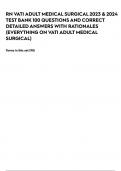RN VATI ADULT MEDICAL SURGICAL 2023 & 2024
TEST BANK 100 QUESTIONS AND CORRECT
DETAILED ANSWERS WITH RATIONALES
(EVERYTHING ON VATI ADULT MEDICAL
SURGICAL)
Terms in this set (90)
,A nurse is caring for a The nurse should plan to administer an opioid
client in the emergency analgesic, such as morphine, for acute pain. Since the
department (ED). client is experiencing nausea and vomiting, the nurse
Physical Examination should also ensure they are NPO. The client is likely
Client presents to the ED experiencing cholecystitis, which typically presents
with upper abdominal pain with nausea, vomiting, upper abdominal pain that
that radiates to the right radiates to the right shoulder, fever, and dyspepsia.
shoulder. Client rates pain The client also has elevated liver enzymes and a WBC
as 7 on a scale of 0 to 10. count, which is consistent with cholecystitis. Surgical
Client also reports nausea, management for cholecystitis might be indicated. The
vomiting, and dyspepsia. nurse should monitor the client's stool and urine color
Client is awake, alert, and because a biliary obstruction from gallstones may
oriented x3. Lung sounds cause clay-colored stools and dark urine.
clear bilaterally, S1 and S2
heart tones noted. All
pulses palpable. Bowel
sounds active in all 4
quadrants.
Complete the diagram by
dragging from the choices
below to specify what
condition the client is
most likely experiencing, 2
actions the nurse should
take to address that
condition, and 2
parameters the nurse
should monitor to assess
the client's progress.
,A nurse is caring for a Fluid volume overload is incorrect. While the client is
client who was just experiencing an increased respiratory rate and
admitted from the shortness of breath, fluid volume overload typically
emergency department includes moist crackles on auscultation, pitting edema
(ED). in dependent areas, neck vein distension, and
Nurses' Notes hypertension.
0945: Right-sided heart failure is incorrect. While clients
Client is experiencing a who have sickle-cell disease are at risk for developing
sickle cell crisis. Client heart failure, the client does not have manifestations
states that they began of right-sided heart failure. Right-sided heart failure
experiencing pain in the typically presents with signs of fluid volume overload,
lower extremities 3 days which includes jugular vein distention, dependent
ago and is now edema, and blood pressure alterations.
experiencing pain in the Acute chest syndrome is correct. The client is most
chest, rating it as 4 on likely experiencing acute chest syndrome, which can
scale of 0 to 10. be caused by respiratory infections and debris from
Oxygen at 3 L/min via sickled cells. The client is displaying manifestations of
nasal cannula in place. acute chest syndrome, which include cough,
Oral mucosa pink, no shortness of breath, wheezing, tachypnea, fever, and
cyanosis. chest pain.
Pulses palpable in all four Pneumonia is correct. The client is most likely
extremities, no peripheral experiencing pneumonia as evidenced by the
edema noted. manifestations of cough, shortness of breath, fever,
Respirations even and tachypnea, blood-tinged sputum, and chest pain.
slightly labored; lung Pneumothorax is incorrect. While the client is
sounds with slight experiencing increased respiratory distress, a
wheezing in left upper pneumothorax typically presents with reduced or
lobe. absent breath sounds and unequal chest expansion.
Abdomen soft and
nontender, bowel sounds
active in all four
quadrants.
0.45% sodium chloride IV
at 200 mL/hr infusing to
left hand with no reports
of pain or swelling at the
site.
, Drag words from the
choices below to fill in
each blank in the
following sentence.
Temperature is consistent with pneumonia. Fever is a
manifestation of pneumonia and is related to
A nurse is caring for a
inflammation or infection.
client.
Breath sounds are consistent with emphysema,
Nurses' Notes
asthma, and pneumonia. The client's wheezing is a
1200:
manifestation of emphysema, asthma, and pneumonia.
Client was admitted to the
It is the result of narrowed airways and alveoli.
unit with shortness of
ABG results are consistent with emphysema and
breath, a nonproductive
pneumonia. The client's ABG results indicate
cough, chest discomfort,
respiratory acidosis, which is a manifestation of
and myalgia. Prefers
emphysema and pneumonia.
orthopneic position. Client
Respiratory rate is consistent with emphysema,
reports that manifestations
asthma, and pneumonia. The client's respiratory rate is
began about 2 days ago.
a manifestation of emphysema, asthma, and
For each assessment
pneumonia.
finding, click to specify if
Heart rate is consistent with emphysema and
the finding is consistent
pneumonia. The client is experiencing tachycardia,
with emphysema, asthma,
which is a manifestation of emphysema and
or pneumonia. Each
pneumonia.
finding may support more
Cough is consistent with emphysema, asthma, and
than 1 disease process.
pneumonia. The client's cough is a manifestation of
emphysema, asthma, and pneumonia.




